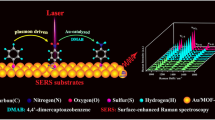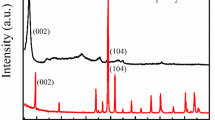Abstract
As a novel two-dimensional (2D) material, metal carbide (MXene) has been identified as a hotspot research topic in the field of surface-enhanced Raman spectroscopy (SERS). Herein, we report the increment of SERS activity of titanium carbide (TiC) by incorporation of gold nanoparticles (Au NPs) by a facile photoreduction process for the detection of antipsychotic drug. TiC anchored with Au NPs produce a remarkable SERS enhancement by the synergistic action of chemical and electromagnetic mechanisms. The hotspots are formed in the nanometer-scale gaps between Au NPs on the TiC surface for the effective interaction with probe molecules. The proposed TiC/Au-NPs SERS substrate was employed for the detection of chlorpromazine (CPZ) with the wide linear range of 10−1–10−10 M and the ultra-low limit of detection of 3.92 × 10−11 M. Besides, the SERS effect of the optimized TiC/Au-NPs for the 532 nm excitation exhibits the enhancement factor in the order of 109 with the relative standard deviation of < 13% for the uniformity and < 8.80% for the reproducibility. To ensure the practical feasibility of the proposed TiC/Au-NPs SERS substrate, the spike and recovery method was used for the detection of CPZ in human biological fluids like urine and saliva. This work can open up a new approach to improve the SERS activity of MXene-based SERS substrate for practical applications, especially the determination of antipsychotic drugs in environmental pollution management.
Graphical abstract






Similar content being viewed by others
References
Palakollu VN, Karpoormath R, Wang L et al (2020) A versatile and ultrasensitive electrochemical sensing platform for detection of chlorpromazine based on nitrogen-doped carbon dots/cuprous oxide composite. Nanomaterials 10:1–15. https://doi.org/10.3390/nano10081513
Kumar JV, Karthik R, Chen SM et al (2018) Highly selective electrochemical detection of antipsychotic drug chlorpromazine in drug and human urine samples based on peas-like strontium molybdate as an electrocatalyst. Inorg Chem Front 5:643–655. https://doi.org/10.1039/c7qi00743d
Kesavan G, Gopi PK, Chen SM, Vinothkumar V (2021) Iron vanadate nanoparticles supported on boron nitride nanocomposite: electrochemical detection of antipsychotic drug chlorpromazine. J Electroanal Chem 882:114982. https://doi.org/10.1016/j.jelechem.2021.114982
Kaleeswarran P, Sriram B, Wang SF, et al (2021) Electrochemical detection of antipsychotic drug in water samples based on nano/sub-microrod-like CuBi2−xInxO4 electrocatalysts. Microchem J 163:. https://doi.org/10.1016/j.microc.2020.105886
Parvin MH (2011) Graphene paste electrode for detection of chlorpromazine. Electrochem commun 13:366–369. https://doi.org/10.1016/j.elecom.2011.01.027
Pharmacol J (1984) Determination, mice by high of chlorpromazine performance with liquid electrochemical in the blood brain of chromatography detection combined Shinji SHIBANOKI. Yukinobu GOTOH and Koichi ISHIKAWA of Pharmacology, Nihon University ltabashi, Tokyo 173(174):169–174
Wong ASY, Choi TLS, Kwok KY et al (2020) Doping control analysis of antipsychotics and other prohibited substances in equine plasma by liquid chromatography/tandem mass spectrometry. J Chromatogr B Anal Technol Biomed Life Sci 1147:122132. https://doi.org/10.1016/j.jchromb.2020.122132
Safaei M, Shishehbore MR (2021) A review on analytical methods with special reference to electroanalytical methods for the determination of some anticancer drugs in pharmaceutical and biological samples. Talanta 229:122247. https://doi.org/10.1016/j.talanta.2021.122247
Lee W, Kang BH, Yang H et al (2021) Spread spectrum SERS allows label-free detection of attomolar neurotransmitters. Nat Commun 12:1–10. https://doi.org/10.1038/s41467-020-20413-8
Zhao Q, Liu G, Zhang H et al (2017) SERS-based ultrasensitive detection of organophosphorus nerve agents via substrate’s surface modification. J Hazard Mater 324:194–202. https://doi.org/10.1016/j.jhazmat.2016.10.049
Barveen NR, Wang TJ, Chang YH (2020) Synergistic action of star-shaped Au/Ag nanoparticles decorated on AgFeO2 for ultrasensitive SERS detection of a chemical warfare agent on real samples. Anal Methods 12:1342–1352. https://doi.org/10.1039/c9ay02347j
Liu R, Jiang L, Yu Z et al (2021) MXene (Ti3C2Tx)-Ag nanocomplex as efficient and quantitative SERS biosensor platform by in-situ PDDA electrostatic self-assembly synthesis strategy. Sensors Actuators, B Chem 333:129581. https://doi.org/10.1016/j.snb.2021.129581
Kumar EA, Kokulnathan T, Wang TJ et al (2020) Two-dimensional titanium carbide (MXene) nanosheets as an efficient electrocatalyst for 4-nitroquinoline N-oxide detection. J Mol Liq 312:113354. https://doi.org/10.1016/j.molliq.2020.113354
Li G, Bin GW, Qiu T et al (2020) Surface-modified two-dimensional titanium carbide sheets for intrinsic vibrational signal-retained surface-enhanced Raman scattering with ultrahigh uniformity. ACS Appl Mater Interfaces 12:23523–23531. https://doi.org/10.1021/acsami.0c00908
Liu R, Jiang L, Lu C et al (2020) Large-scale two-dimensional titanium carbide MXene as SERS-active substrate for reliable and sensitive detection of organic pollutants. Spectrochim Acta - Part A Mol Biomol Spectrosc 236:118336. https://doi.org/10.1016/j.saa.2020.118336
Limbu TB, Chitara B, Garcia Cervantes MY et al (2020) Unravelling the thickness dependence and mechanism of surface-enhanced Raman scattering on Ti3C2TXMXene nanosheets. J Phys Chem C 124:17772–17782. https://doi.org/10.1021/acs.jpcc.0c05143
Satheeshkumar E, Makaryan T, Melikyan A et al (2016) One-step solution processing of Ag, Au and Pd@MXene hybrids for SERS. Sci Rep 6:1–9. https://doi.org/10.1038/srep32049
Zhang Q, Guo W, He L et al (2020) A new SERS substrate of self-assembled monolayer film of gold nanoparticles on silicon wafer for the rapid detection of polycyclic aromatic hydrocarbons. Mater Chem Phys 250:122994. https://doi.org/10.1016/j.matchemphys.2020.122994
Zhao X, Campbell S, Wallace GQ et al (2020) Branched Au nanoparticles on nanofibers for surface-enhanced Raman scattering sensing of intracellular pH and extracellular pH gradients. ACS Sensors. https://doi.org/10.1021/acssensors.0c00784
Barveen NR, Wang TJ, Chang YH (2021) Photochemical decoration of silver nanoparticles on silver vanadate nanorods as an efficient SERS probe for ultrasensitive detection of chloramphenicol residue in real samples. Chemosphere 275:130115. https://doi.org/10.1016/j.chemosphere.2021.130115
Barveen NR, Wang TJ, Chang YH, Yuan-Liu Z (2020) Ultrasensitive and reusable SERS probe for the detection of synthetic dyes in food industry through hybrid flower-shaped ZnO@Ag nanostructures. J Alloys Compd 157952. https://doi.org/10.1016/j.jallcom.2020.157952
RiswanaBarveen N, Wang TJ, Chang YH (2020) In-situ deposition of silver nanoparticles on silver nanoflowers for ultrasensitive and simultaneous SERS detection of organic pollutants. Microchem J 159:105520. https://doi.org/10.1016/j.microc.2020.105520
Do PQT, Huong VT, Phuong NTT et al (2020) The highly sensitive determination of serotonin by using gold nanoparticles (Au NPs) with a localized surface plasmon resonance (LSPR) absorption wavelength in the visible region. RSC Adv 10:30858–30869. https://doi.org/10.1039/d0ra05271j
Li H, Ma S, Chen L, Yu Z (2020) Carbon-deficient titanium carbide with highly enhanced hardness. Front Phys 8:. https://doi.org/10.3389/fphy.2020.00364
Guan Y, Su H, Yang C et al (2018) Ordering of hollow Ag-Au nanospheres with butterfly wings as a biolate. Sci Rep 8:1–7. https://doi.org/10.1038/s41598-018-27679-5
Sarata G, Sakai M, Takahashi H (2000) Nanosecond time-resolved resonance Raman and absorption studies of the photochemistry of chlorpromazine and related phenothiazine derivatives. J Raman Spectrosc 31:785–790. https://doi.org/10.1002/1097-4555
Pavel IE, Alnajjar KS, Monahan JL et al (2012) Estimating the analytical and surface enhancement factors in surface-enhanced raman scattering (SERS): A novel physical chemistry and nanotechnology laboratory experiment. J Chem Educ 89:286–290. https://doi.org/10.1021/ed200156n
Martínez A, Vargas R, A component of the puzzle, when attempting to understand antipsychotics: a theoretical study of chemical reactivity indexes. J Pharmacol Pharm Res, 1:1–8, https://doi.org/10.31038/JPPR.2018115
Riswana N, Wang T, Chang Y (2021) Photochemical synthesis of Ag / Au / AgCl heterostructure from Ag nanowires as a reusable SERS substrate for ultrasensitive detection of analgesics and antibiotics. Chem Eng J 423:130191. https://doi.org/10.1016/j.cej.2021.130191
Liu C, Xu X, Wang C et al (2020) ZnO/Ag nanorods as a prominent SERS substrate contributed by synergistic charge transfer effect for simultaneous detection of oral antidiabetic drugs pioglitazone and phenformin. Sensors Actuators, B Chem 307:127634. https://doi.org/10.1016/j.snb.2019.127634
Wang K, Sun DW, Pu H et al (2019) Stable, flexible, and high-performance SERS chip enabled by a ternary film-packaged plasmonic nanoparticle array. ACS Appl Mater Interfaces 11:29177–29186. https://doi.org/10.1021/acsami.9b09746
Senger RS, Kavuru V, Sullivan M et al (2019) Spectral characteristics of urine specimens from healthy human volunteers analyzed using Raman chemometric urinalysis (Rametrix). PLoS ONE 14:1–11. https://doi.org/10.1371/journal.pone.0222115
Goggin MM, Tann CM, Miller A et al (2017) Catching fakes: new markers of urine sample validity and invalidity. J Anal Toxicol 41:121–126. https://doi.org/10.1093/jat/bkw119
Carpenter GH (2013) The secretion, components, and properties of saliva. Annu Rev Food Sci Technol 4:267–276. https://doi.org/10.1146/annurev-food-030212-182700
Funding
This work was being financially supported by the Ministry of Science and Technology of the Republic of China, Taiwan, under grants MOST 107–2221-E-027–079-MY3.
Author information
Authors and Affiliations
Corresponding author
Ethics declarations
Conflict of interest
The authors declare no competing interests.
Additional information
Publisher’s note
Springer Nature remains neutral with regard to jurisdictional claims in published maps and institutional affiliations.
Supplementary Information
Below is the link to the electronic supplementary material.
Rights and permissions
About this article
Cite this article
Barveen, N.R., Wang, TJ. & Chang, YH. A photochemical approach to anchor Au NPs on MXene as a prominent SERS substrate for ultrasensitive detection of chlorpromazine. Microchim Acta 189, 16 (2022). https://doi.org/10.1007/s00604-021-05118-z
Received:
Accepted:
Published:
DOI: https://doi.org/10.1007/s00604-021-05118-z




